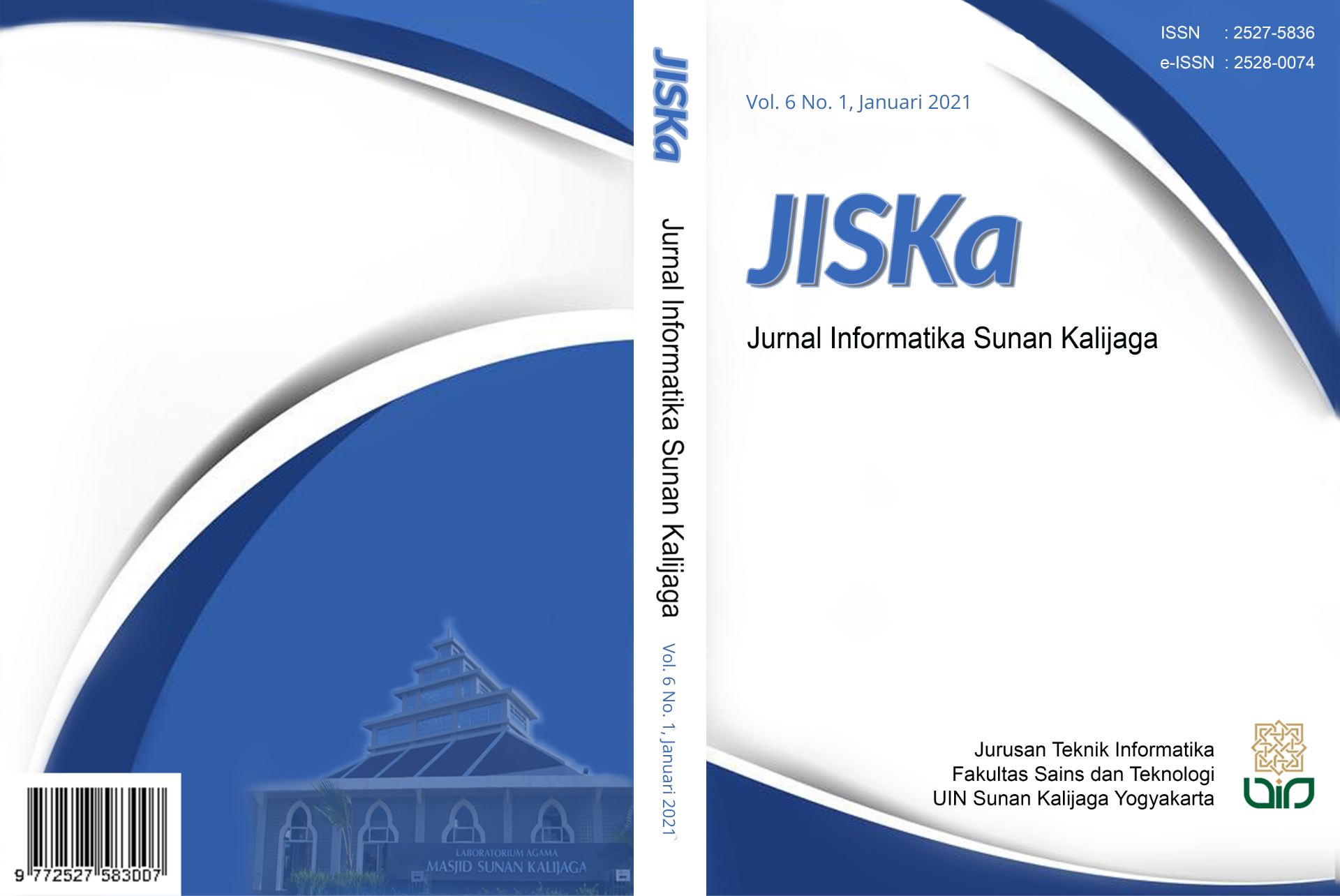Efektifitas Penggunaan Association Rules Mining dalam Personalisasi Website
DOI:
https://doi.org/10.14421/jiska.2021.61-07Abstract
As the usage of the internet grows, more and more information is obtained, thus presenting challenges, especially for users and website owners. Website users often have difficulty finding products or services that are relevant to their needs caused by abundant amounts of products and services delivered on a website. Website owners often find it difficult to convey information about the right products and services to certain target users. Based on the problem given above, we can conclude that a recommendation system approach that can improve personalization on their website is needed. The recommendation system approach must be able to provide navigation on the website to make it more adaptive towards the interests and information needed by the user. This study uses Association Rules formed from Microsoft web access log data by finding visitor patterns based on frequently visited web site pages. From the results of the research conducted, the performance of the method used has a precision value of 0.896, 0.058 recall, and F-measure 0.104. Whereas the measurement of the accuracy value resulted in a performance recommendation of exactly 3%, an acceptable rate of 87%, and 10% incorrect. This research shows that the Association Rules method can increase the effectiveness of website personalization to provide relevant information recommendations for visitors. For further research, it can concentrate on improving existing methods thus website personalization becomes more adaptive.
References
Al-Qaed, F., & Sutcliffe, A. (2006). Adaptive decision support system (ADSS) for B2C e-commerce. Proceedings of the 8th International Conference on Electronic Commerce The New E-Commerce: Innovations for Conquering Current Barriers, Obstacles and Limitations to Conducting Successful Business on the Internet - ICEC ’06, 492. https://doi.org/10.1145/1151454.1151528
Bobadilla, J., Ortega, F., Hernando, A., & Gutiérrez, A. (2013). Recommender systems survey. Knowledge-Based Systems, 46, 109–132. https://doi.org/10.1016/j.knosys.2013.03.012
Das, P., Jisha, R. C., & Sajeev, G. P. (2017). Adaptive web personalization system using splay tree. 2017 International Conference on Advances in Computing, Communications and Informatics (ICACCI), 1582–1587. https://doi.org/10.1109/ICACCI.2017.8126067
Eke, C. I., Norman, A. A., Shuib, L., & Nweke, H. F. (2019). A Survey of User Profiling: State-of-the-Art, Challenges, and Solutions. IEEE Access, 7, 144907–144924. https://doi.org/10.1109/ACCESS.2019.2944243
Garrigós, I., Gomez, J., & Houben, G.-J. (2010). Specification of personalization in web application design. Information and Software Technology, 52(9), 991–1010. https://doi.org/10.1016/j.infsof.2010.04.001
Han, K., Yi, M. Y., & Kim, J. (2019). Search Personalization in Folksonomy by Exploiting Multiple and Temporal Aspects of User Profiles. IEEE Access, 7, 95610–95619. https://doi.org/10.1109/ACCESS.2019.2927026
Hawalah, A., & Fasli, M. (2015). Dynamic user profiles for web personalisation. Expert Systems with Applications, 42(5), 2547–2569. https://doi.org/10.1016/j.eswa.2014.10.032
Kanoje, S., Girase, S., & Mukhopadhyay, D. (2015). User Profiling Trends, Techniques and Applications. International Journal of Advance Foundation and Research in Computer (IJAFRC), 1(1).
Knijnenburg, B. P., Willemsen, M. C., Gantner, Z., Soncu, H., & Newell, C. (2012). Explaining the user experience of recommender systems. User Modeling and User-Adapted Interaction, 22(4–5), 441–504. https://doi.org/10.1007/s11257-011-9118-4
Lee, S., & Koubek, R. J. (2010). The effects of usability and web design attributes on user preference for e-commerce web sites. Computers in Industry, 61(4), 329–341. https://doi.org/10.1016/j.compind.2009.12.004
Mulya, D. P. (2019). Analisa Dan Implementasi Association Rule Dengan Algoritma Fp-Growth Dalam Seleksi Pembelian Tanah Liat. Teknologi Dan Sistem Informasi Bisnis, 1(1), 47–57.
Percin, I., Yagin, F. H., Guldogan, E., & Yologlu, S. (2019). ARM: An Interactive Web Software for Association Rules Mining and an Application in Medicine. 2019 International Artificial Intelligence and Data Processing Symposium (IDAP), 1–5. https://doi.org/10.1109/IDAP.2019.8875885
Prasetya, C. S. D. (2017). Sistem Rekomendasi Pada E-Commerce Menggunakan K-Nearest Neighbor. Jurnal Teknologi Informasi Dan Ilmu Komputer, 4(3), 194. https://doi.org/10.25126/jtiik.201743392
Purwati, Y. (2011). STANDARD FEATURES OF E-COMMERCE USER INTERFACE FOR THE WEB. Journal of Arts, Science & Commerce, 2(3), 77–87.
Rianto, Nugroho, L. E., & Santosa, P. I. (2016). Pattern discovery of Indonesian customers in an online shop: A case of fashion online shop. 2016 3rd International Conference on Information Technology, Computer, and Electrical Engineering (ICITACEE), 313–316. https://doi.org/10.1109/ICITACEE.2016.7892462
Siswanto, B., & Thariqa, P. (2018). Association Rules Mining for Identifying Popular Ingredients on YouTube Cooking Recipes Videos. 2018 Indonesian Association for Pattern Recognition International Conference (INAPR), 95–98. https://doi.org/10.1109/INAPR.2018.8627002
Sulikowski, P., Zdziebko, T., Turzyński, D., & Kańtoch, E. (2018). Human-website interaction monitoring in recommender systems. Procedia Computer Science, 126, 1587–1596. https://doi.org/10.1016/j.procs.2018.08.132
Downloads
Additional Files
Published
How to Cite
Issue
Section
License
Authors who publish with this journal agree to the following terms as stated in http://creativecommons.org/licenses/by-nc/4.0
a. Authors retain copyright and grant the journal right of first publication with the work simultaneously licensed under a Creative Commons Attribution License that allows others to share the work with an acknowledgement of the work's authorship and initial publication in this journal.
b. Authors are able to enter into separate, additional contractual arrangements for the non-exclusive distribution of the journal's published version of the work (e.g., post it to an institutional repository or publish it in a book), with an acknowledgement of its initial publication in this journal.
c. Authors are permitted and encouraged to post their work online (e.g., in institutional repositories or on their website) prior to and during the submission process, as it can lead to productive exchanges, as well as earlier and greater citation of published work.










